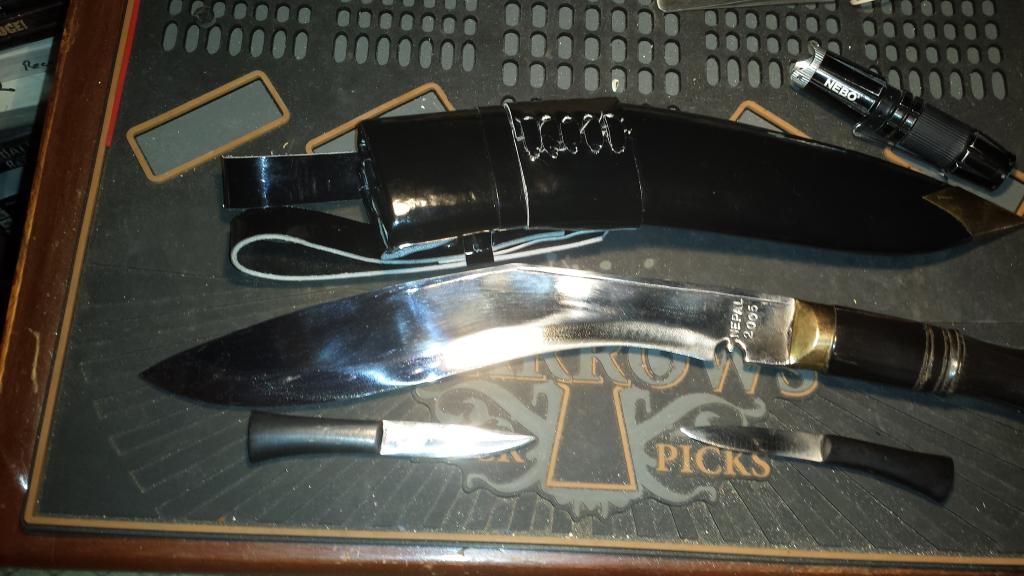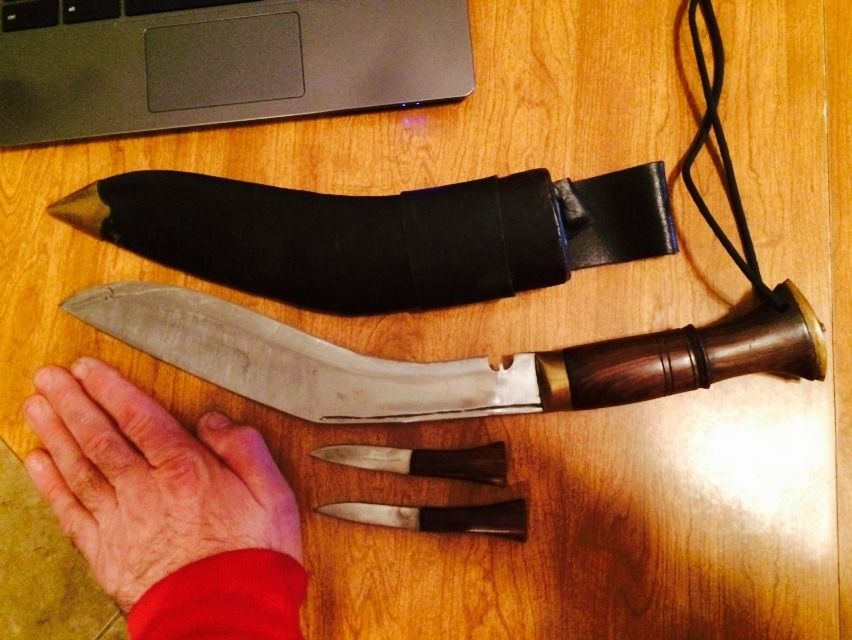Nepalese Kukri

Oops cur the pommel off I'll update later as I also had a few too many B'day beers at the Pub.
(21:55:20) HAL 9001RC:: Heh heh uh heh uh heh uh uh heh PhoneMan said ass
 |
 |
 |

Neilau wrote:Nice !!
Of the two smaller blades, one should be sharp and one should be blunt.
The blunt one is for striking a spark off a flint to start a fire and the sharp one is like a pocket knife.
Though, I'm told that a true Ghurkha cannot un-sheath his blade without spilling blood, so he has to nick himself with the small sharp blade before he can show it to anyone. That's just what I heard when in Nepal.
There is a story about the choil but I can't remember it - perhaps someone else here knows it.
BTW what length is it?
Great present !!!

Neilau wrote:Thanks Doogs.
Didn't know about maintaining the edge.
I love this site.
GWiens2001 wrote:Watched as this one was being made many a year ago about 20 or so kilometers out of Kathmandu:
My hand is next to it for scale. Have carried it in many places over the years.
The goat foot on the main blade is sharp on mine. You use it to nick the heel of your palm if you draw it and do not put it away blooded. That tradition ONLY applies to knives used for military purposes. These are general utility knives for just about anything from fighting to skinning animals to chopping wood. (These are much better than a hatchet for chopping wood). There is also a proper way to use the knife if you are going to use it for fighting with the intent of chopping off a head, arm or leg. The ghurkas told me that you hold the handle loose in your hand with only your middle finger and thumb touching. The other fingers are hanging loose. As you swing, just an instant before you contact the soon-to-be severed limb, you snap your other fingers tight. This whips the knife into more of a strong arc, increasing impact force.
The two smaller 'blades' - the sharp one is for general small knife chores. The other one, as stated above, looks the same on the 'blade' and the spine - both flat with somewhat sharp(ish) edges. It can be used to strike a flint as mentioned above, but it is actually used to sharpen the blade of the larger knife. Obviously, in this day of diamond steels, it is better to use one of those.
Use light machine oil to lubricate the blade. If your sheath is loose, wet the leather. It will shrink as it dries, making the sheath tighten around the blade. If it is too tight, then lube the blade, fully put it into the sheath, then smack the knife (while in the sheath) just below where the blade enters the sheath on the inside edge, against your palm a couple of times. That will help stretch the leather a little, making the knife easier to remove. Even if the sheath is holding properly, you should slightly wedge the blade in the above method to hold it in place better.
These knives are typically made from spring steel. Mine came from a Mercedes truck rear leaf spring. It is heavy and solid.
After 10-15 years of heavy use, the glue (made from a tree sap in Nepal) may break apart, causing the bolster to come loose, or even the blade to loosen. If that happens, do what I did... go to a golf pro shop and buy some two part shafting epoxy. That epoxy is designed to handle shocks and impacts without breaking apart. It has been over 10 years since I did the repair on my knife, and it is still going strong.
Take care of that knife. They are not expensive at all, but they are very reliable. You can depend on them. Great present, Doogs!
Gordon
EDIT: The lanyard is not something they do there. Drilled the hole and put the lanyard in myself, as I prefer it that way.

Neilau wrote:Gordon.
Thanks for the extra info. I love knife lore.
You say that you were there when it was made. Was it forged to shape?
I believe that forging a curve into a blade is very difficult and quite an art.
Unfortunately mine was "liberated" from me many years ago and the only ones that I have come across since then were "tourist models" or insanely expensive.
You are correct. They are really good "choppers" and an excellent all purpose large "camp knife".
Deadlock wrote:Not a choil, but a cho. See this link:
http://www.gurkhas-kukris.com/khukuri/parts.php
Interesting to see these myths are round the world now! One such being that the knife must draw blood whenever it is unsheathed. Not true. The kukri is an all-purpose everyday tool. It actually must be the modern day equivalent of the Stone Age hand axe.
The story I've read is that if the knife is unsheathed 'with intent', in a battle during a war, then it must draw blood.
But the ol' bootlace bit? Now that IS a myth!
Users browsing this forum: No registered users